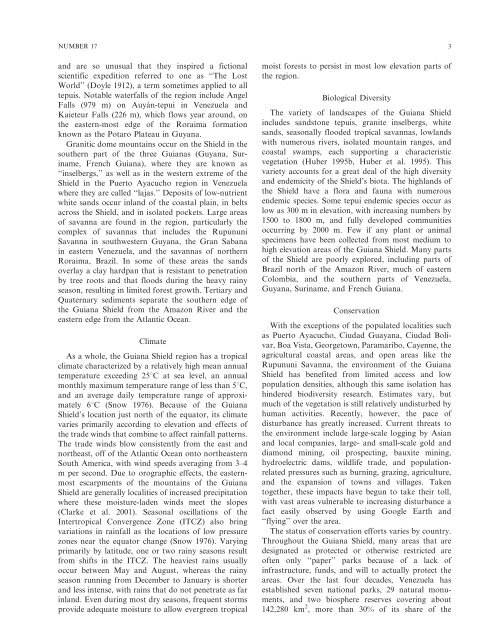Biological Society of Washington - Department of Botany ...
Biological Society of Washington - Department of Botany ...
Biological Society of Washington - Department of Botany ...
Create successful ePaper yourself
Turn your PDF publications into a flip-book with our unique Google optimized e-Paper software.
NUMBER 17 3<br />
and are so unusual that they inspired a fictional<br />
scientific expedition referred to one as ‘‘The Lost<br />
World’’ (Doyle 1912), a term sometimes applied to all<br />
tepuis. Notable waterfalls <strong>of</strong> the region include Angel<br />
Falls (979 m) on Auyán-tepui in Venezuela and<br />
Kaieteur Falls (226 m), which flows year around, on<br />
the eastern-most edge <strong>of</strong> the Roraima formation<br />
known as the Potaro Plateau in Guyana.<br />
Granitic dome mountains occur on the Shield in the<br />
southern part <strong>of</strong> the three Guianas (Guyana, Suriname,<br />
French Guiana), where they are known as<br />
‘‘inselbergs,’’ as well as in the western extreme <strong>of</strong> the<br />
Shield in the Puerto Ayacucho region in Venezuela<br />
where they are called ‘‘lajas.’’ Deposits <strong>of</strong> low-nutrient<br />
white sands occur inland <strong>of</strong> the coastal plain, in belts<br />
across the Shield, and in isolated pockets. Large areas<br />
<strong>of</strong> savanna are found in the region, particularly the<br />
complex <strong>of</strong> savannas that includes the Rupununi<br />
Savanna in southwestern Guyana, the Gran Sabana<br />
in eastern Venezuela, and the savannas <strong>of</strong> northern<br />
Roraima, Brazil. In some <strong>of</strong> these areas the sands<br />
overlay a clay hardpan that is resistant to penetration<br />
by tree roots and that floods during the heavy rainy<br />
season, resulting in limited forest growth. Tertiary and<br />
Quaternary sediments separate the southern edge <strong>of</strong><br />
the Guiana Shield from the Amazon River and the<br />
eastern edge from the Atlantic Ocean.<br />
Climate<br />
As a whole, the Guiana Shield region has a tropical<br />
climate characterized by a relatively high mean annual<br />
temperature exceeding 25uC at sea level, an annual<br />
monthly maximum temperature range <strong>of</strong> less than 5uC,<br />
and an average daily temperature range <strong>of</strong> approximately<br />
6uC (Snow 1976). Because <strong>of</strong> the Guiana<br />
Shield’s location just north <strong>of</strong> the equator, its climate<br />
varies primarily according to elevation and effects <strong>of</strong><br />
the trade winds that combine to affect rainfall patterns.<br />
The trade winds blow consistently from the east and<br />
northeast, <strong>of</strong>f <strong>of</strong> the Atlantic Ocean onto northeastern<br />
South America, with wind speeds averaging from 3–4<br />
m per second. Due to orographic effects, the easternmost<br />
escarpments <strong>of</strong> the mountains <strong>of</strong> the Guiana<br />
Shield are generally localities <strong>of</strong> increased precipitation<br />
where these moisture-laden winds meet the slopes<br />
(Clarke et al. 2001). Seasonal oscillations <strong>of</strong> the<br />
Intertropical Convergence Zone (ITCZ) also bring<br />
variations in rainfall as the locations <strong>of</strong> low pressure<br />
zones near the equator change (Snow 1976). Varying<br />
primarily by latitude, one or two rainy seasons result<br />
from shifts in the ITCZ. The heaviest rains usually<br />
occur between May and August, whereas the rainy<br />
season running from December to January is shorter<br />
and less intense, with rains that do not penetrate as far<br />
inland. Even during most dry seasons, frequent storms<br />
provide adequate moisture to allow evergreen tropical<br />
moist forests to persist in most low elevation parts <strong>of</strong><br />
the region.<br />
<strong>Biological</strong> Diversity<br />
The variety <strong>of</strong> landscapes <strong>of</strong> the Guiana Shield<br />
includes sandstone tepuis, granite inselbergs, white<br />
sands, seasonally flooded tropical savannas, lowlands<br />
with numerous rivers, isolated mountain ranges, and<br />
coastal swamps, each supporting a characteristic<br />
vegetation (Huber 1995b, Huber et al. 1995). This<br />
variety accounts for a great deal <strong>of</strong> the high diversity<br />
and endemicity <strong>of</strong> the Shield’s biota. The highlands <strong>of</strong><br />
the Shield have a flora and fauna with numerous<br />
endemic species. Some tepui endemic species occur as<br />
low as 300 m in elevation, with increasing numbers by<br />
1500 to 1800 m, and fully developed communities<br />
occurring by 2000 m. Few if any plant or animal<br />
specimens have been collected from most medium to<br />
high elevation areas <strong>of</strong> the Guiana Shield. Many parts<br />
<strong>of</strong> the Shield are poorly explored, including parts <strong>of</strong><br />
Brazil north <strong>of</strong> the Amazon River, much <strong>of</strong> eastern<br />
Colombia, and the southern parts <strong>of</strong> Venezuela,<br />
Guyana, Suriname, and French Guiana.<br />
Conservation<br />
With the exceptions <strong>of</strong> the populated localities such<br />
as Puerto Ayacucho, Ciudad Guayana, Ciudad Bolívar,<br />
Boa Vista, Georgetown, Paramaribo, Cayenne, the<br />
agricultural coastal areas, and open areas like the<br />
Rupununi Savanna, the environment <strong>of</strong> the Guiana<br />
Shield has benefited from limited access and low<br />
population densities, although this same isolation has<br />
hindered biodiversity research. Estimates vary, but<br />
much <strong>of</strong> the vegetation is still relatively undisturbed by<br />
human activities. Recently, however, the pace <strong>of</strong><br />
disturbance has greatly increased. Current threats to<br />
the environment include large-scale logging by Asian<br />
and local companies, large- and small-scale gold and<br />
diamond mining, oil prospecting, bauxite mining,<br />
hydroelectric dams, wildlife trade, and populationrelated<br />
pressures such as burning, grazing, agriculture,<br />
and the expansion <strong>of</strong> towns and villages. Taken<br />
together, these impacts have begun to take their toll,<br />
with vast areas vulnerable to increasing disturbance a<br />
fact easily observed by using Google Earth and<br />
‘‘flying’’ over the area.<br />
The status <strong>of</strong> conservation efforts varies by country.<br />
Throughout the Guiana Shield, many areas that are<br />
designated as protected or otherwise restricted are<br />
<strong>of</strong>ten only ‘‘paper’’ parks because <strong>of</strong> a lack <strong>of</strong><br />
infrastructure, funds, and will to actually protect the<br />
areas. Over the last four decades, Venezuela has<br />
established seven national parks, 29 natural monuments,<br />
and two biosphere reserves covering about<br />
142,280 km 2 , more than 30% <strong>of</strong> its share <strong>of</strong> the
















